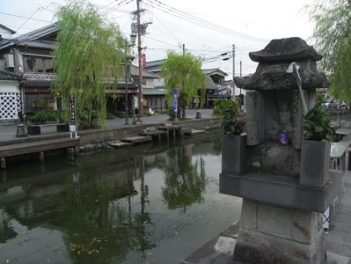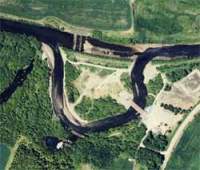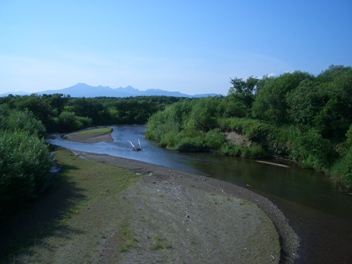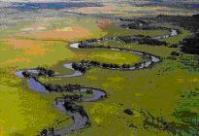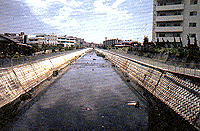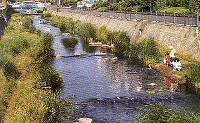
The Asian River Restoration Network was established in Nov. 2006 to support the exchange of information relating to environmental restoration of rivers and watersheds. JRRN has a role of ARRN secretariat currently.
Go to ARRN website

< 2011.3:World's WATERFRONT:JAPAN Monthly Archive >
Yanagawa’s canals were once devastated. The citizens participated in the movement to improve environment, ahead of other cities. Their driving force was that, during the over 100 meetings with the government, each member recalled the “life with the canals,” the days people enjoyed fishing and playing in the water.
With the understanding and cooperation by the citizens, dredging was unexpectedly well proceeded in a short period, together with the citizens. It resulted in a dramatic decline of mosquitoes, in changing previously flood prone areas to flood-free, and in a rise of citizens’ morale for river protection. Especially, the ex-moat sections in the central target areas, where coastal planted landscaping and walking trails were constructed, are now organically utilized as the relaxation place for the local people, and have many tourists, contributing to the Yanagawa City’s economy.
>>More details (PDF 79KB)
By JRRN-secre | Category: History and traditional restoration,Kyushu | Comment(0) | Trackback(0) |
Date: 2011.03.31 18:16
Tsurumi River basin was quite activated from the late 1960s with rapid city development, but it also came to have various problems such as flood control, environment, and disaster prevention. Given the situation that flood control safety level was hard to maintain, a committee of academic experts, basin local government, and river administrator was set to find a basin-wide solution for integration of river development and flood control measures. This is a pioneer of total flood control efforts in Japan. Beyond the basin measures such as rain runoff control, the local government’s urbanization plan and development projects were involved.
>>More details (PDF 54KB)
By JRRN-secre | Category: Community and urban river restoration,Kanto | Comment(0) | Trackback(0) |
Date: 2011.03.31 18:15
Shibetsu River has experienced constructions to straighten its winding stream to lower its underground water level, aiming at preventing flood and at better drainage of the basin, which was originally a peat district. Changes of the times have changed Shibetsu River’s requirements. With the local people’s voice asking for a better environment, Hokkaido Regional Development Bureau is working on a nature-restoring river development plan, aiming at restoring the nature-abundant original river conditions. In order to research the effect of straightened streams, the winding streams are partially restored as an experiment.
>>More details (PDF 51KB)
By JRRN-secre | Category: Nature oriented restoration,Hokkaido | Comment(0) | Trackback(0) |
Date: 2011.03.31 18:13
Kushiro River
(source: RFC)
|
The natural wetland environment of Kushiro River, which is a registered wetland designated under the Ramsar Convention in 1980, has deteriorated because of the land development in the surrounding area, the increased amount of sediment flowing into the wetland caused by the straightening of the inflow rivers and the lowering of the water table.
The "Kushiro Wetland Natural Environment Regeneration Project," is being conducted mainly by the Ministry of Land, Infrastructure, Transport and Tourism and Ministry of the Environment to rehabilitate and conserve the wetland by restoring the meandering streams to their original state and controlling the wetland vegetation.
>>More details (PDF39KB)
By JRRN-secre | Category: Nature oriented restoration,Hokkaido | Comment(0) | Trackback(0) |
Date: 2011.03.31 18:11
Before
(source: RFC)
|
|
After
(source: RFC)
|
In 1982, Yokohama City began developing shallow water channels along the Itachi River in order to restore the waterfront to its natural state. Prior to this, mudflats had developed as a result of earlier river improvement construction projects.
There were several goals to this river Restoration plan: to maintain sufficient water depth (i.e. to restore the water depth to pre-construction levels),to restore waterfront vegetation, to revive the riverbed microtopography in both rapid and slow streams, and to develop the river-walk. Through experimentation with various construction methods, the waterfront environment has now regained its natural vitality and once again attracts the local people.
>>More details (PDF 48KB)
By JRRN-secre | Category: Community and urban river restoration,Kanto | Comment(0) | Trackback(0) |
Date: 2011.03.31 18:10
In Dokai Bay, located in the northwest part of Kitakyushu City, harmful substances discharged by concentrated heavy chemical factories accumulated. It was once called "a dead sea".
However, as a result of dredging of Dokai Bay through citizens' movements by women's associations and activities by Kitakyushu district labor unions, it has been regenerated as a treasure trove of fishery products. Although there are still some heavy chemical factories in the coastal area, the water quality has been dramatically improved and it is planned to construct Dokai Bio Park and Dohoku and Okudoukai green spaces. In this way, an environment where many wild birds and animals and plants can live is being regenerated.
>>More details (PDF 46KB)
By JRRN-secre | Category: Bay and lake restoration,Kyushu | Comment(0) | Trackback(0) |
Date: 2011.03.31 18:09
